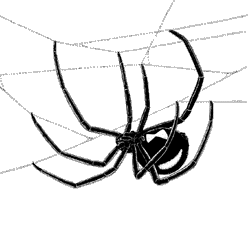

Family : Theridiidae
Other common names: Western Black Widow
Black widow spiders generally live in trash, closets, attics, woodpiles,
garages and other dark places. They are found throughout California,
especially in the warmer regions such as the Central Valley and Southern
California. Only the female spider is dangerous to humans.
What does a black widow spider look like?
The black widow spider is a shiny, inky black spider with a large round
tail segment (abdomen). Including its legs, the black widow generally
measures from one-half inch to one inch in length. Red to orange-colored
markings, usually in the shape of an hourglass, are found on the underside
of the belly.
Description
The female of this sexually dimorphic species is usually ¼ to ¾
inch (12 to 19 mm) in body length, shiny black or very dark brown, with
a large rounded or oval abdomen which is characterized by a bright red-orange
hourglass shape on the underside. The male is less than half the size
of the female, medium brown with cream-colored markings on legs and abdomen.
The young of both sexes resemble the male.
What are the symptoms of a bite?
A black widow spider bite gives the appearance of a target, with a pale
area surrounded by a red ring. Severe muscle pain and cramps may develop
in the first two hours. Severe cramps are usually first felt in the back,
shoulders, abdomen and thighs. Other symptoms include weakness, sweating,
headache, anxiety, itching, nausea, vomiting, difficult breathing and
increased blood pressure. Young children, the elderly and those with high
blood pressure are at highest risk of developing symptoms from a black
widow spider bite.
How dangerous are black widow spider bites?
If a black widow spider bites a person, do not panic! No one in the United
States
has died from a black widow spider bite in over 10 years. Very often the
black widow
will not inject any venom into the bite and no serious symptoms develop.
Wash the
wound well with soap and water to help prevent infection.
If muscle cramps develop, take the patient to the nearest hospital. Some
victims, especially
young children, may be admitted overnight for observation and treatment.
There is treatment
for a black widow spider bite that can take care of the symptoms. Various
medications are
used to treat the muscle cramps, spasms and pain of a bite. Black widow
spider antivenin is
seldom necessary.
Distribution and Habitat
Different species of Latrodectus are found throughout most of North America,
more commonly in warmer climates. Black widows are common around man-made
structures such as garages, lawn furniture, and woodpiles. They also live
in a variety of natural habitats.
Ecology
Black widow spider
The black widow preys mainly upon insects that it traps in the web. The
web is irregular and strong to the touch in comparison to other webs.
Some species of spider wasps prey upon black widows. Black widows are
shy, sedentary, and largely nocturnal. They are not aggressive, but will
bite in self-defense.
Life History
The female mates only once in her lifetime, retaining sperm for future
egg-laying. The smaller male is sometimes eaten by the female following
mating, hence the name “widow.” This characteristic, however,
is not limited to black widows, but can occur after mating in many arachnids,
most of which are highly predatory. The female lays approximately 300
eggs at one time and encases them in a round, cream-colored egg sac made
of her silk. One spider produces several sacs within its one- to two-year
lifespan, but only one sac at a time. The spiderlings disperse by ballooning.
The black widow is one of two species within our region that is potentially dangerous to humans (the brown spider is the other). The bite can kill a human, but this is rare. More often, the bite is painful and causes serious reactions, including nausea, dizziness and abdominal cramps.